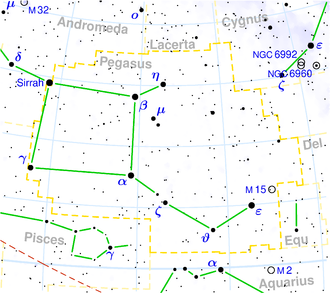NGC 7800
| Galaxy NGC 7800 |
|
|---|---|

|
|
| SDSS recording | |
| AladinLite | |
| Constellation | Pegasus |
|
Position equinox : J2000.0 , epoch : J2000.0 |
|
| Right ascension | 23 h 59 m 36.3 s |
| declination | + 14 ° 48 ′ 20 ″ |
| Appearance | |
| Morphological type | In the? |
| Brightness (visual) | 12.5 mag |
| Brightness (B-band) | 13.1 mag |
| Angular expansion | 2.3 ′ × 1.6 ′ |
| Position angle | 42 ° |
| Surface brightness | 13.7 mag / arcmin² |
| Physical data | |
| Redshift | 0.005851 ± 0.000013 |
| Radial velocity | 1754 ± 4 km / s |
|
Stroke distance v rad / H 0 |
(85 ± 6) x 10 6 ly (26.1 ± 1.8) Mpc |
| diameter | 55,000 ly |
| history | |
| discovery | William Herschel |
| Discovery date | December 24, 1783 |
| Catalog names | |
| NGC 7800 • UGC 12885 • PGC 73177 • CGCG 433-012 • MCG + 02-01-007 • IRAS 23570 + 1431 • KUG 2357 + 145 • 2MASX J23593630 + 1448200 • GC 5039 • H II-10 • h 2291 • HIPASS J2359 +14 | |
NGC 7800 is an irregular galaxy of Hubble type in the constellation Pegasus at the northern sky . It is estimated to be 85 million light years from the Milky Way and about 55,000 light years in diameter.
The object was discovered by William Herschel on December 24, 1783 .
